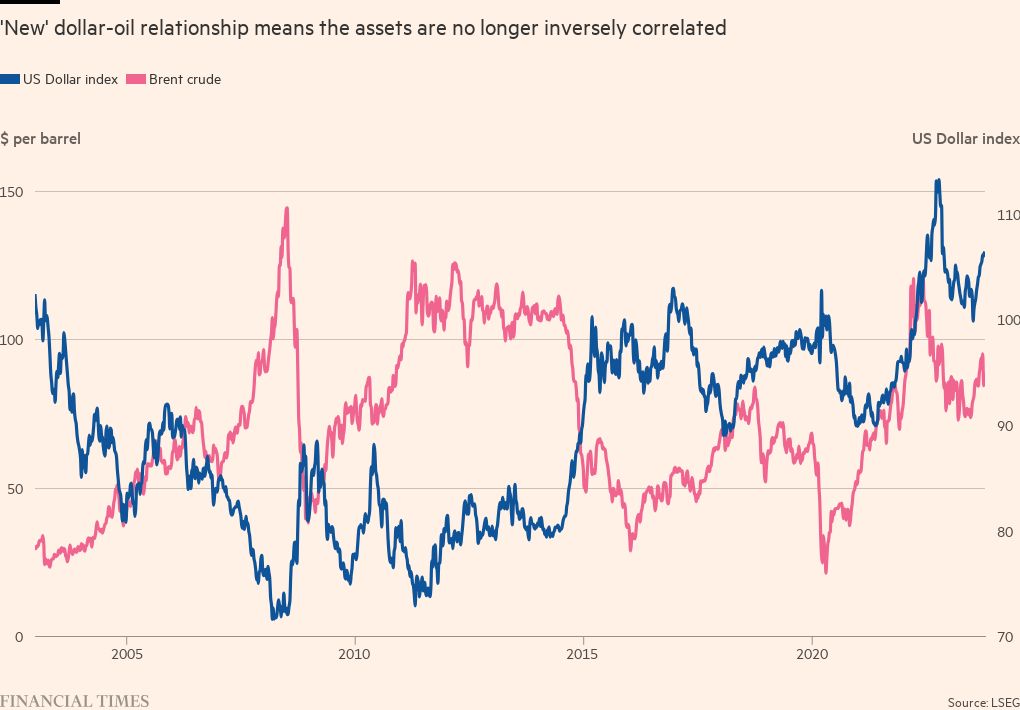The dollar has joined the commodity currency club

Roula Khalaf, Editor of the FT, selects her favourite stories in this weekly newsletter.
The writer is a former chief investment strategist at Bridgewater Associates
As economies evolve, relationships between asset prices can change, often in such a quiet, evolutionary way that investors get caught off guard. That is what has happened with oil prices and the dollar. A change in the historical relationship is increasingly rippling through global economies and markets and putting emerging-market oil importers in a particularly unenviable spot.
The “new” dollar-oil relationship goes back decades, the result of years of research and innovation in the US oil patch. New approaches to production, especially fracking and horizontal drilling, helped the US to transform from a large net importer to a net exporter of natural gas as of 2017. From 2019, it also has been net exporter of energy overall. It also became the world’s largest liquefied natural gas exporter last year.
Being a net exporter of these critical commodities means that the dollar joins the “commodity currency” club. Today, in a way similar to dynamics seen in the Canadian dollar or Norwegian krone, rising oil prices improve the country’s terms of trade and provide a measure of currency support.
Unlike its other club members, though, the dollar’s outsized role in global currency markets means that such strength creates large, often unwelcome global ripples. Specifically, today’s oil-dollar relationship means even greater pain for energy importers, especially in emerging economies. They face higher import costs while the strong dollar undermines their local currencies, increasing inflation and financial stability risks.
The latest rally in crude oil prices, with Brent crude up more than 20 per cent since late June, came on the back of resilient demand but, perhaps more important, an increased sense that supply would stay constrained for the foreseeable future. On this front, Saudi Arabia led the charge, extending voluntary production cuts through the end of this year in an effort to support prices. The climb in oil prices was followed by appreciation of the dollar; indeed, the DXY index of the dollar against major currencies rose more than 6 per cent between mid-July and mid-October, according to Bloomberg.
Of course, currencies are affected by a number of factors — trends in the terms of trade just one of them. In the dollar’s case, recent strength has also reflected the contribution from oil prices to fears that US inflation would fall more slowly than previously expected, in turn adding pressure on the Federal Reserve to keep interest rates higher for longer.
This trifecta — higher energy prices, higher US interest rates and a stronger dollar — is the last thing many countries want to see right now. That’s particularly true for energy importers in Asia, where growth is already challenged by the drag emanating from a struggling China. South Korea, one of the world’s largest net oil importers, provides a good case study. In September, its consumer prices rose by the most in five months, lifted mainly by commodity prices. The central bank has kept policy interest rates steady. While hampering an already soft manufacturing sector, officials are more focused on bringing inflation down. That focus has included the currency: the central bank has been intervening regularly to prevent the won from weakening and raising import costs. Just last month, the won lost some 2 per cent against the dollar despite the central bank depleting reserves by roughly $4bn (1 per cent of total reserves), according to Bloomberg data.
While investors should factor in the evolved structural dollar-oil relationship as they consider country exposures, it is also important to remember that oil-dollar correlations will still vary over shorter time periods, depending on what factors are dominating each asset. While today’s narrative is focused on oil supply, especially in the light of potential for a broader disruption in the Middle East, tomorrow the focus could easily switch to a decrease in demand if the delayed impact of tighter global monetary policy bites more.
Ironically, falling oil prices, while they may hurt US terms of trade, may not be enough to sustainably, materially dent the dollar. What has also mattered historically is whether global investors see greater recession risks as reason to increase exposures to liquid US assets such as Treasuries.
Such purchases have often helped support the dollar during economic downturns. That said, ongoing US government dysfunction and growing debt sustainability worries means we should watch out for another possible structural relationship change, this time between economic cycles and Treasury demand, with the dollar reflecting the outcome.

Comments